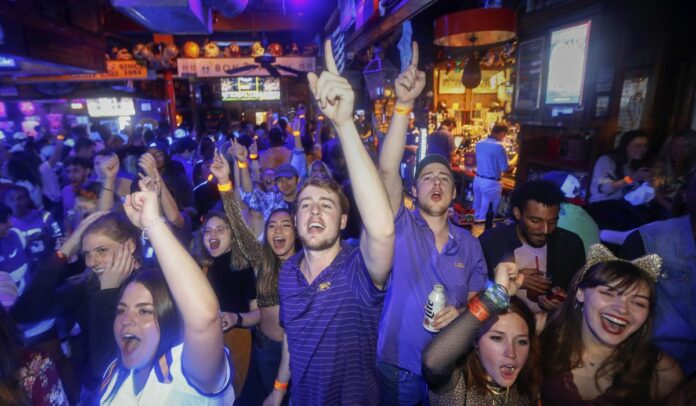BATON ROUGE, La. — Public health officials warn that college carousing and fraternity parties at universities across the South have become “superspreader events” that created COVID-19 hot spots.
Hundreds of cases have been tied to student parties at Ole Miss in Oxford, Mississippi, and at Louisiana State University in Baton Rouge, where nearly three dozen players on the school’s football team were quarantined.
Although the schools are mostly out for the summer, many students have remained in off-campus housing during the coronavirus crisis, and the onset of fraternity and sorority rushes has drawn more young adults back to the schools.
“Many of the new cases can be traced back to bars and those around Tigerland,” said Louisiana Gov. John Bel Edwards, a Democrat, referring to a thicket of ramshackle bars just southwest of the LSU campus that has long been a huge party zone for students.
The bars closed Friday.
Public health officials attribute the party atmosphere during the pandemic to a feeling of invulnerability coupled with less-severe symptoms and rare mortality in younger people for COVID-19. However, young people risk spreading the disease to more vulnerable populations.
The University of Georgia and other schools continued fraternity activity during the pandemic, while others, including Florida State, ordered a Greek system shutdown.
Louisiana this week passed the grim milestones of more than 50,000 positive cases and 3,000 deaths attributed to COVID-19. Neither the rise nor the source came as a surprise to officials across the Deep South.
“We do think they’re at the front end or [the middle] of a significant outbreak,” said Dr. Thomas Dobbs, the Mississippi state health officer who linked a cluster of cases to Ole Miss fraternity parties.
“What we’ve identified so far is that it seems to be related to community transmission and social gatherings, and we have linked quite a few patients back to fraternity rush parties that are happening in the summer,” he said.
Mississippi’s restrictions allow gatherings up to 20 people indoors and 50 outside. Mississippi has had fewer large political demonstrations than Louisiana in recent weeks, but the number of cases is up in both states.
More than 162 Ole Miss students have tested positive for COVID-19, almost doubling the total number of cases Oxford has had since March, according to local officials.
On Monday, 489 people in Mississippi were hospitalized with COVID-19, although the number requiring ventilators or intensive care unit treatment has held steady since April. The exact numbers were uncertain, however, because the state has acknowledged problems with the reporting of its health statistics.
Positive COVID-19 cases have risen across the Sun Belt, bucking hopes that the summer heat would diminish the virus.
“That’s certainly not happening in the hottest and most humid parts of the country,” said Mr. Edwards, who halted plans to advance the state’s reopening to phase three.
More than 100 cases were tied to a recent string of parties in Tigerland, and at least another 30 to high school graduation parties in New Orleans, authorities said.
“I think everyone saw the quarantine being lifted a little bit and everyone was tired of being cooped up,” said Turner Dailey, who tested positive on March 11.
Mr. Dailey, 21, who has not shown symptoms for several days, did not contract the virus at Tigerland, but he knows a handful of people and some bar workers who did. Bars that stayed open were teeming with young adults.
“That ended up not being the right decision,” he noted wryly.
The coronavirus broke through the defenses of LSU’s defending national championship football team, with at least 30 players — more than a quarter of the roster — forced into quarantine over the weekend, as first reported by Sports Illustrated.
It was unclear how many of those players tested positive for the virus, which originated last year in Wuhan, China, and has been blamed for more than 474,000 deaths worldwide, including more than 123,000 in the U.S.






